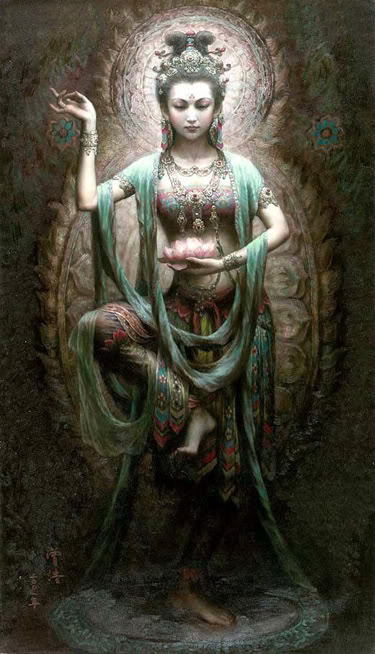
Welcome to the Practical Magic Blog Party here on 'I Heart the Goddess' and hosted by the lovely Anna over at
'Frosted Petunias'. Many thanks to our hostess for bringing us all together to share in our love of a magical movie! And pop over to the
'Practical Magic Blog Party' blog to find your way around all the lovely bloggers out there who are sharing with us today.

One of the many things I took away with me from the movie was the use of candles. They seemed to be in every room in one way or another, bringing their sultry light to the scene. For me candles conjure up magick, mystery, and a sense of wonder and enlightment. They light the darkness and warm our hearts and minds to the possibilities rising from the smoke.
And so my party post is all about candles and the infinite uses they have in our lives, both mundane and magickal.
Candles in the Mundane WorldCandles have been in use for thousands of years, yet little is known about their origin. There is no historical record of the first candles, however clay candle holders dating from the 4th century BC have been found in Eygpt. The earliest people credited with developing the "wicked" candle are the ancient Romans, before 3,000 BC. They used rolled papyrus and dipped it repeatedly in melted tallow (cattle or sheep fat) or beeswax.
Early Chinese candles are said to have been molded in paper tubes, using rolled rice paper for the wick, and wax from an indigenous insect that was combined with seeds. In Japan, candles were made of wax extracted from tree nuts, while in India, candle wax was made by boiling the fruit of the cinnamon tree. The first known candle in America dates to the 1st century AD. Native Americans burned oily fish(candlefish) wedged into a forked stick. Early missionaries in the southwestern United States boiled the bark of the Cerio tree and skimmed the wax.

In the middle ages most western cultures relied primarily on candles made from animal fat(tallow). A major improvement came when beeswax candles were introduced in Europe. Unlike animal-based tallow, beeswax burned pure and cleanly, without producing a smoky flame. It also emitted a pleasant, sweet smell rather than the foul, bitter odor of tallow. Beeswax candles were widely used for church ceremonies, but because they were expensive, few individuals other than the wealthy could afford them in their home. Tallow candles were the common household candle for Europeans, and by the 13th century, candlemaking had become a guild craft in England and France. The candlemakers(chandlers) went from house to house making candles from the kitchen fats saved for that purpose, or made and sold their own candles from small candle shops.
In America colonial women discovered that boiling the grayish-green berries of bayberry bushes produced a sweet-smelling wax that burned cleanly. However, extracting the wax from the berries was extremely tedious. As a result, the popularity of bayberry candles soon diminished. The growth of the whaling industry in the late 18th century brought the first major change in candlemaking since the Middle Ages,when spermaceti, a wax obtained by crystallizing sperm whale oil, became available in quantity. Like beeswax, the spermaceti wax did not elict a repugnant odor when burned, and produced a significantly brighter light. It also was harder than either tallow or beeswax, so it wouldn't soften or bend in the summer. A pure spermaceti candle is the measure for candlepower. Candlepower is a common term for describing light output. It is based on a measurement of the light produced by a pure spermaceti candle weighing one sixth of a pound, burning at a rate of 120 grams per hour.

During the 19th century most of the major contemporary candlemaking developements occurred. In the 1820s, French chemist Michel Eugene Chevreul discovered how to extract steric acid from animal fatty acids. This led to the development of stearin wax which was hard, durable and burned cleanly. Stearin candles remain popular in Europe today. In 1834, inventor Joseph Morgan helped to further the modern-day candle industry by developing a machine that allowed for continuous production of molded candles by using a cylinder with a movable piston to eject candles as they solidified. With the introduction of mechanized production, candles became an easily affordable commodity for the masses. Paraffin wax was introduced in the 1850s, after chemists learned how to efficiently separate the naturally-occurring waxy subtance from petroleum and refine it. Odorless and bluish-white in color, paraffin was a boon to candlemaking because it burned cleanly, consistently and was more economical to produce than any other candle fuel.

Candles in MagickCandle magick is probably one of the simplest forms of magick to perform. All that is needed is a candle and some matches (Witches prefer matches to lighters because sulphur - once known as brimstone - has been believed since the Middle Ages to possess the power of purification). Candle magick can also be seen to be complete within itself as the body of the candle is made up from the elements of Earth and Water. Fire is added by lighting the candle and Spirit is represented by the wick, as the wick is where the potential of the candle lies and will be unfolded with. With the candle lit, the flame of your intent will burn.

Candle magick has been used for centuries for magick and ritual. Candles are lit at the Sabbats and Esbats and is a practice that is used in many different religions, cultures and traditions. Candles invoke the divine, they create a sense of ceremony and they are fascinating to look at. Candles can be purchased anywhere, by anyone, without anyone blinking an eye or suspecting magick and witchcraft!

The flickering flame of a candle can help you to focus on your wishes, making your heart's desire come true. Try using candles the next time you want to make something happen in your life!
Unwittingly, you probably performed your first act of candle magick when you blew out the candles on your birthday cake whilst making a wish. This tradition is based on the three principles of magick; concentration, will power and visualization. You concentrated on the candles, blew them out with all your might and visualized your wish coming true - absolute magick!

Choosing a Candle1. Choose a plain candle of uniform shape. Having unusual or large candles can be distracting and is therefore not suitable for magickal use.
2. Candles used for magick should always be virgin (unused) at the start of the ritual. Using secondhand candles or other materials in magick can have disastrous results as they might have picked up vibrations from previous use, even if it was just on a dinner table.
3. If at all possible, making your own candles for magickal use will increase the magickal potency of the candle many times. It is very easy to make your own candles. Simply heat the wax until it liquifies and then pour it into a mould which is threaded with a wick. The wax is left to cool after which the mold is removed. Essential oils and colors can be added to the wax for extra effect.
4. Charge your candle before using it in ritual. This can be done by annointing it with oils associated with the ritual or magick you intend on performing or by simply touching it and charging it with your own energy. Whilst charging the candle, visualize the north and south poles - rub the oil into the candle starting at the center and rubbing down towards south; then starting at the center again, rub up towards north.

Below are some charts for astral color, candle color and days of the week correspondences.



Candles in RitualIn Wicca and related forms of neo-paganism, the candle is frequently used on the altar to represent the presence of the God and Goddess, and in the four corners of a ritual circle to represent the presence of the four elements being Earth, Air, Fire, and Water. When used in this manner, lighting and extinguishing the candle marks the opening and closing of the ritual.

Candle Magick for MabonI thought it would be nice to include a Mabon ritual here for those whole celebrate this Sabbatt.
You'll need:
- An unscented candle in a harvest color such as yellow, orange, or brown.
- Your choice of Money Oil or essential oil of cinnamon, orange, or ginger.
- Something to inscribe the candle with such as a pencil, stylus, or athame.
- A pinch of dried basil, sage or dill.
If you normally cast a circle or invoke Deity, do so now. Using the pencil, stylus or athame inscribe your intent upon the candle. For example, if you need money to pay the bills, carve that on the candle. If you just want extra fun money, write that on the candle too. If you're not sure how much you need, you can use symbols of money such as the dollar sign ($) or a runic symbol. In traditional runes, Fehu is the sign of wealth, prosperity and financial gain. And since I'm into runes, I've included the Fehu symbol here.

Once you've completed the inscription, anoint the candle with the Money Oil. If you don't have Money Oil, use another essential oil that brings prosperity; cinnamon, orange or ginger are all good to use. Focus your intent into the candle, drawing abundance to you. Rub a small amount of the dried basil, sage or dill (all herbs connected with money) into the oil. As you do, clearly visualize how you will be using the money that comes your way. Will you use it to pay off debt? Buy a new car? Take a class for personal growth?
Light the candle and meditate on the flame. Continue focusing on your intent and imagine it building, first as a small spark, and then growing into a large ball of light. Maintain this image as long as you can, and then release it into the candle flame. Make sure the candle is in a safe place so as not to be a fire hazard (a bowl of sand is perfect for this) and allow the candle to burn out on its own.
NEVER LEAVE A BURNING CANDLE UNATTENDED!

I hope you enjoyed visiting today and remember to keep the 'magick' lit in your life.
















































































